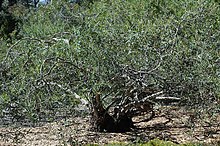
Eucalyptus notabilis, commonly known as Blue Mountains mahogany or mountain mahogany, is a species of small to medium-sized tree endemic to eastern Australia. It has rough, fibrous bark on the trunk and branches, lance-shaped to curved adult leaves, flower buds in groups of between seven and eleven, white flowers and hemispherical or conical fruit.
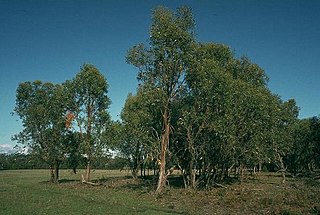
Eucalyptus kitsoniana, commonly known as the Gippsland mallee or bog gum, is a species of small tree or mallee and is endemic to Victoria. It has mostly smooth bark, a crown containing juvenile, intermediate and adult leaves, flower buds in groups of seven, white flowers and sessile, cup-shaped to hemispherical fruit.
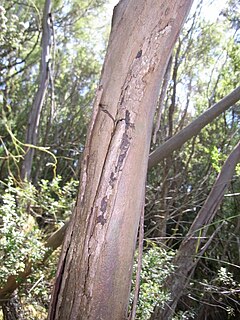
Eucalyptus imlayensis, commonly known as the Mount Imlay mallee, is a species of small, straggly mallee that is endemic to the far south east of New South Wales, only occurring near the summit of Mount Imlay. It has mostly smooth bark, lance-shaped to curved adult leaves, flower buds in groups of three, white flowers and cup-shaped, bell-shaped or hemispherical fruit.
Eucalyptus nitida, commonly known as the Smithton peppermint, is a species of tree or mallee that is endemic to Tasmania. It has varying amounts of loose, fibrous or flaky bark, lance-shaped to curved adult leaves, flower buds in groups of nine to fifteen, white flowers and cup-shaped to hemispherical fruit.

Eucalyptus ligustrina, commonly known as the privet-leaved stringybark, is a species of shrub, mallee or small tree that is endemic to New South Wales. It has rough, stringy bark, lance-shaped to egg-shaped adult leaves, flower buds in groups of between seven and fifteen, white flowers and hemispherical or shortened spherical fruit.
Eucalyptus elaeophloia, commonly known as Nunniong gum or olive mallee, is a species of tree or mallee that is endemic to a restricted area in Victoria. It has mostly smooth greenish to greyish bark, glossy green, lance-shaped adult leaves, flower buds in groups of three, white flowers and conical or hemispherical fruit.

Eucalyptus serraensis, commonly known as the Grampians stringybark, is a species of small tree or mallee that is endemic to the Grampians in Victoria, Australia. It has rough, stringy, fibrous or flaky bark on the trunk and sometimes also the branches, smooth bark above, lance-shaped to egg-shaped or round adult leaves, sessile flower buds in groups of three or seven, white flowers and hemispherical or cup-shaped fruit.
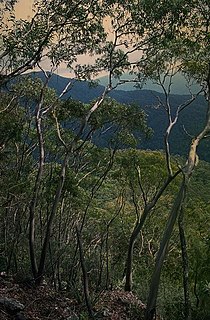
Eucalyptus baeuerlenii, commonly known as Baeuerlen's gum, is a mallee, sometimes a tree, that is endemic to New South Wales. It has smooth bark throughout, lance-shaped to curved adult leaves, oblong to spindle-shaped buds in groups of three in leaf axils, white flowers and bell-shaped, cup-shaped or conical fruit. It grows in mountain areas in the south of the state.

Eucalyptus banksii, commonly known as the Tenterfield woollybutt, is a tree that is endemic to eastern Australia. It has rough fibrous or flaky bark, lance-shaped to curved leaves, flower buds without a pedicel in groups of seven in leaf axils, white flowers and hemispherical to cup-shaped or conical fruit.

Eucalyptus boliviana, commonly known as Bolivia Hill stringybark or Bolivia stringybark is a shrub or a mallee, sometimes a small tree and is endemic to a small area in northern New South Wales. It is a stringybark with four-sides stems, broadly lance-shaped adult leaves, flower buds arranged in groups of seven, yellow flowers and hemispherical to broadly funnel-shaped fruit.
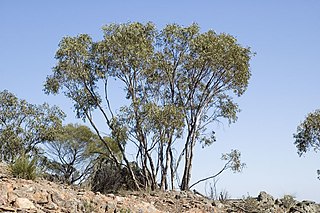
Eucalyptus dwyeri, commonly known as Dwyer's red gum or Dwyer's mallee gum, is a species of small tree, sometimes a mallee that is endemic to eastern Australia. It has smooth, white or cream-coloured bark, lance-shaped to curved adult leaves, flower buds in groups of seven and conical, bell-shaped or hemispherical fruit.
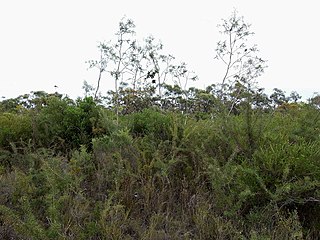
Eucalyptus sturgissiana, commonly known as steel box or Ettrema mallee, is a species of mallee that is endemic to a small area of New South Wales. It has smooth, mottled bark, narrow lance-shaped adult leaves, often with juvenile leaves persisting in the crown, flower buds in groups of seven, white flowers and hemispherical to bell-shaped fruit.
Eucalyptus litorea, commonly known as saline mallee, is a species of mallee that is endemic to a small area on the southern coast of Western Australia. It has hard, rough grey bark on the trunk, smooth grey bark above, lance-shaped adult leaves, flower buds in groups of seven, white flowers and cylindrical or barrel-shaped fruit.
Eucalyptus prominens is a species of mallee that is endemic to a small area on the west coast of Western Australia. It has smooth greyish bark, sometimes with rough bark near the base, lance-shaped adult leaves, flower buds in groups of seven or nine, white flowers and conical fruit.

Eucalyptus rugosa, commonly known as the Kingscote mallee, is a species of mallee that is endemic to coastal areas of southern Western Australia and South Australia. It has smooth bark, lance-shaped adult leaves, flower buds in groups of between seven and thirteen, white flowers and cup-shaped, conical or hemispherical fruit.

Eucalyptus flindersii, commonly known as the South Australian grey mallee, mallee red gum, or grey mallee, is a species of mallee that is endemic to South Australia. It usually has smooth, pinkish grey bark, lance-shaped to curved adult leaves, flower buds in groups of three or seven and conical or hemispherical fruit with the valves protruding.
Eucalyptus percostata, commonly known as the rib-capped mallee or Devils peak mallee, is a species of mallee that is endemic to South Australia. It has smooth bark, lance-shaped adult leaves, flower buds in groups of seven, creamy white flowers and cup-shaped to conical fruit. It is only known from a few locations in the Flinders Ranges.

Eucalyptus falciformis, commonly known as the Grampians peppermint or western peppermint, is a species of tree or mallee that is endemic to south eastern Australia. It has smooth bark, sometimes with rough, fibrous bark at the base, narrow lance-shaped to egg-shaped or curved adult leaves, flower buds in groups of eleven to twenty one, white flowers and cup-shaped to shortly cylindrical fruit.

Eucalyptus gregoryensis is a species of small tree or mallee that is endemic to the Northern Territory. It has smooth, powdery white bark, lance-shaped to curved adult leaves, flower buds usually in groups of three, white flowers and cup-shaped to hemispherical fruit.
Eucalyptus pauciflora subsp. hedraia, commonly known as snow gum, is a mallee or small tree that is endemic to a small area of Victoria, Australia. It has smooth bark, branchlets that are often glaucous, glossy green lance-shaped to egg-shaped or elliptical adult leaves, flower buds in groups of between eleven and fifteen, white flowers and hemispherical or cup-shaped fruit. It differs from other subspecies of E. pauciflora in having larger, sessile, glaucous buds and broader, hemispherical fruit.
